工程管理英文论文
工程管理英文作文
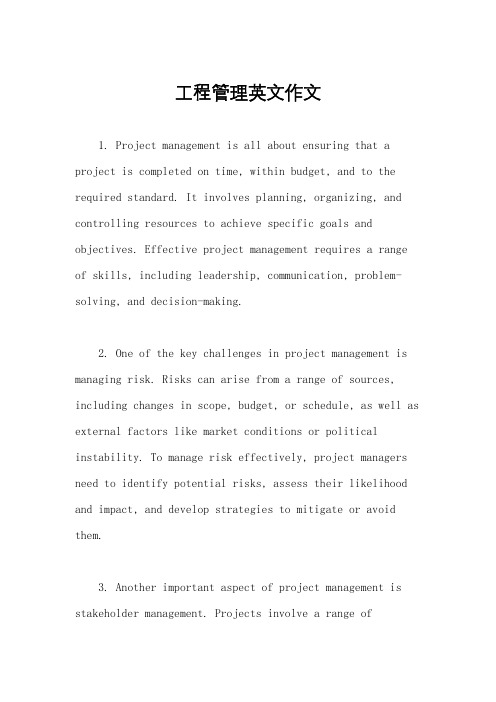
工程管理英文作文1. Project management is all about ensuring that a project is completed on time, within budget, and to the required standard. It involves planning, organizing, and controlling resources to achieve specific goals and objectives. Effective project management requires a range of skills, including leadership, communication, problem-solving, and decision-making.2. One of the key challenges in project management is managing risk. Risks can arise from a range of sources, including changes in scope, budget, or schedule, as well as external factors like market conditions or political instability. To manage risk effectively, project managers need to identify potential risks, assess their likelihood and impact, and develop strategies to mitigate or avoid them.3. Another important aspect of project management is stakeholder management. Projects involve a range ofstakeholders, including customers, suppliers, team members, and other interested parties. Effective stakeholder management involves identifying and engaging with stakeholders, understanding their needs and expectations, and communicating with them throughout the project lifecycle.4. Project management also involves managing resources effectively. This includes managing budgets, schedules, and personnel, as well as ensuring that the project has the necessary equipment, materials, and infrastructure to succeed. Effective resource management requires careful planning, monitoring, and control to ensure that resources are used efficiently and effectively.5. Finally, project management involves continuous improvement. Projects are complex and dynamic, and there is always room for improvement. Project managers need to be constantly evaluating their performance, identifying areas for improvement, and implementing changes to improveproject outcomes. This requires a commitment to learningand development, as well as a willingness to adapt to changing circumstances.。
工程管理专业 英文 作文

工程管理专业英文作文英文:As a project management major, I believe that effective communication and organization are key components to successful project completion. In order to ensure that all team members are on the same page, it is crucial to establish clear goals and expectations from the beginning. This can be achieved through the use of project management tools such as Gantt charts and project plans.Another important aspect of project management is risk management. It is important to identify potential risks and create contingency plans to mitigate them. This can involve conducting a risk analysis and developing a risk management plan.In addition, effective leadership is essential in project management. A good leader should be able to motivate and inspire team members, as well as provideguidance and support when needed. This can involve setting clear expectations, providing regular feedback, and recognizing team members for their contributions.Overall, project management requires a combination of technical skills and soft skills such as communication, organization, and leadership. By utilizing these skills, project managers can ensure that projects are completed on time, within budget, and to the satisfaction of all stakeholders.中文:作为一名工程管理专业的学生,我相信有效的沟通和组织是成功完成项目的关键组成部分。
工程管理英文文献1500词范文
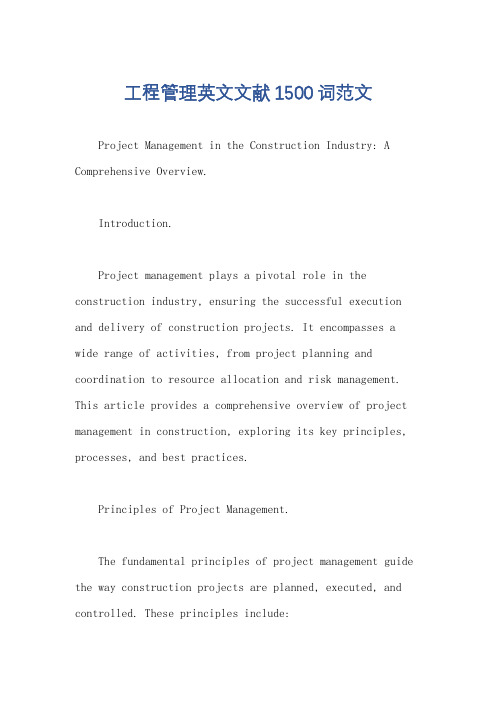
工程管理英文文献1500词范文Project Management in the Construction Industry: A Comprehensive Overview.Introduction.Project management plays a pivotal role in the construction industry, ensuring the successful execution and delivery of construction projects. It encompasses a wide range of activities, from project planning and coordination to resource allocation and risk management. This article provides a comprehensive overview of project management in construction, exploring its key principles, processes, and best practices.Principles of Project Management.The fundamental principles of project management guide the way construction projects are planned, executed, and controlled. These principles include:Project Planning: Establishing a clear and detailed plan that outlines project objectives, scope, deliverables, and timelines.Communication: Maintaining effective communication among project stakeholders, including owners, contractors, suppliers, and consultants.Risk Management: Identifying and mitigating potential risks that may impact project outcomes.Collaboration: Fostering teamwork and collaboration among project members to achieve common goals.Control: Regularly monitoring and evaluating project progress to ensure adherence to plans and objectives.Project Management Processes.Project management in construction involves several key processes that are typically executed sequentially:1. Project Initiation: Defining the project scope, objectives, and feasibility.2. Project Planning: Developing a detailed project plan that outlines tasks, resources, and timelines.3. Project Execution: Implementing the project plan and managing resources to achieve project deliverables.4. Project Monitoring and Control: Tracking progress, identifying deviations, and taking corrective actions to ensure successful project completion.5. Project Closure: Finalizing deliverables, completing documentation, and evaluating project performance.Best Practices in Project Management.To optimize project outcomes, construction industry professionals follow established best practices, such as:Use of Project Management Software: Utilizing project management software can streamline planning, scheduling, and collaboration.Stakeholder Engagement: Actively engaging project stakeholders throughout the project lifecycle to ensure alignment and buy-in.Risk Management Framework: Implementing a structured risk management framework to identify, assess, and manage project risks effectively.Change Management Process: Establishing a clear and proactive process for managing project changes to minimize disruptions and ensure project success.Continuous Improvement: Regularly reviewing project performance and seeking opportunities for improvement to enhance future project outcomes.Benefits of Effective Project Management.Effective project management in construction brings numerous benefits, including:On-Time Delivery: Adherence to project schedules and timelines, meeting stakeholder expectations.Cost Control: Managing project costs effectively, minimizing overruns and staying within budget.Quality Assurance: Ensuring high-quality construction outcomes that meet project specifications and industry standards.Risk Mitigation: Identifying and managing risks proactively, safeguarding projects from potential threats and ensuring smooth execution.Improved Stakeholder Satisfaction: Maintaining strong relationships with project stakeholders by delivering successful projects that align with their needs and objectives.Conclusion.Project management is essential for the successful execution of construction projects. By understanding its key principles, following established processes, and implementing best practices, construction industry professionals can optimize project outcomes, ensure on-time delivery, control costs, manage risks, and enhance stakeholder satisfaction. As the construction industry continues to evolve, leveraging advanced technologies and innovative approaches to project management will become increasingly critical for project success.。
工程项目管理的英文文献(3篇)
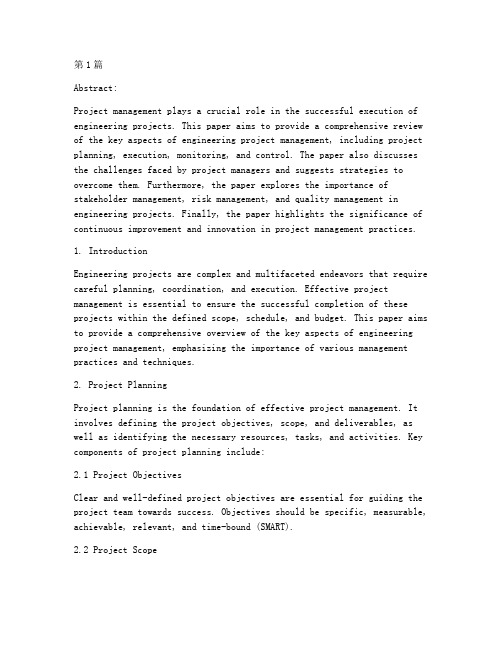
第1篇Abstract:Project management plays a crucial role in the successful execution of engineering projects. This paper aims to provide a comprehensive review of the key aspects of engineering project management, including project planning, execution, monitoring, and control. The paper also discusses the challenges faced by project managers and suggests strategies to overcome them. Furthermore, the paper explores the importance of stakeholder management, risk management, and quality management in engineering projects. Finally, the paper highlights the significance of continuous improvement and innovation in project management practices.1. IntroductionEngineering projects are complex and multifaceted endeavors that require careful planning, coordination, and execution. Effective project management is essential to ensure the successful completion of these projects within the defined scope, schedule, and budget. This paper aims to provide a comprehensive overview of the key aspects of engineering project management, emphasizing the importance of various management practices and techniques.2. Project PlanningProject planning is the foundation of effective project management. It involves defining the project objectives, scope, and deliverables, as well as identifying the necessary resources, tasks, and activities. Key components of project planning include:2.1 Project ObjectivesClear and well-defined project objectives are essential for guiding the project team towards success. Objectives should be specific, measurable, achievable, relevant, and time-bound (SMART).2.2 Project ScopeThe project scope defines the boundaries and deliverables of the project. It is crucial to clearly define the scope to avoid scope creep andensure that the project remains on track.2.3 Work Breakdown Structure (WBS)A work breakdown structure (WBS) is a hierarchical decomposition of the project scope into smaller, manageable components. It helps inorganizing and planning the project activities.2.4 Resource PlanningEffective resource planning ensures that the necessary resources, suchas personnel, equipment, and materials, are available at the right time and in the right quantity.2.5 Schedule PlanningA project schedule outlines the sequence of activities and their durations. Critical path method (CPM) and program evaluation and review technique (PERT) are commonly used techniques for schedule planning.3. Project ExecutionProject execution is the phase where the planned activities are implemented. This phase involves coordinating the efforts of the project team, managing resources, and ensuring that the project progresses as planned. Key aspects of project execution include:3.1 CommunicationEffective communication is crucial for the successful execution of engineering projects. Regular meetings, progress reports, and collaboration tools are essential for maintaining open lines of communication among project stakeholders.3.2 Risk ManagementRisk management involves identifying, assessing, and mitigatingpotential risks that may impact the project. Techniques such as riskidentification, risk analysis, and risk response planning are used to manage risks effectively.3.3 Quality ManagementQuality management ensures that the project deliverables meet the required standards and specifications. Techniques such as quality planning, quality control, and quality assurance are employed to maintain high-quality standards.4. Project Monitoring and ControlProject monitoring and control involve tracking the project's progress, comparing it with the baseline plan, and taking corrective actions when necessary. Key activities in this phase include:4.1 Progress TrackingProgress tracking involves monitoring the completion of project activities and comparing them with the baseline schedule. Techniques such as earned value management (EVM) are used for progress tracking.4.2 Performance MeasurementPerformance measurement involves assessing the project's performance against the planned objectives, schedule, and budget. This helps in identifying deviations and taking corrective actions.4.3 Change ManagementChange management involves managing changes to the project scope, schedule, and resources. Effective change management ensures that changes are controlled and documented.5. Stakeholder ManagementStakeholder management is crucial for the successful execution of engineering projects. It involves identifying, analyzing, and managing the interests, expectations, and influence of stakeholders. Key aspects of stakeholder management include:5.1 Stakeholder IdentificationIdentifying all stakeholders involved in the project is essential for understanding their needs and expectations.5.2 Stakeholder AnalysisStakeholder analysis helps in assessing the power, interest, and influence of stakeholders to determine their level of engagement in the project.5.3 Stakeholder EngagementEngaging stakeholders throughout the project lifecycle ensures their satisfaction and support for the project objectives.6. Risk ManagementRisk management is a critical aspect of engineering project management.It involves identifying, assessing, and mitigating potential risks that may impact the project. Key risk management techniques include:6.1 Risk IdentificationRisk identification involves identifying potential risks that may affect the project's success.6.2 Risk AnalysisRisk analysis involves assessing the probability and impact ofidentified risks to prioritize them.6.3 Risk Response PlanningRisk response planning involves developing strategies to mitigate, avoid, transfer, or accept risks.7. Quality ManagementQuality management is essential for ensuring that the projectdeliverables meet the required standards and specifications. Key quality management techniques include:7.1 Quality PlanningQuality planning involves defining the quality objectives and requirements for the project.7.2 Quality ControlQuality control involves monitoring the project activities to ensurethat they comply with the defined quality standards.7.3 Quality AssuranceQuality assurance involves establishing and maintaining processes to ensure that the project deliverables meet the required quality standards.8. Continuous Improvement and InnovationContinuous improvement and innovation are crucial for the long-term success of engineering projects. This involves:8.1 Lessons LearnedDocumenting lessons learned from completed projects helps in identifying best practices and areas for improvement.8.2 Continuous Improvement InitiativesImplementing continuous improvement initiatives, such as Lean and Six Sigma, helps in enhancing project performance and reducing waste.9. ConclusionEffective project management is essential for the successful execution of engineering projects. This paper has provided a comprehensive review of the key aspects of engineering project management, including project planning, execution, monitoring, and control. Additionally, the paper has highlighted the importance of stakeholder management, risk management, and quality management in engineering projects. Finally, the paper has emphasized the significance of continuous improvement and innovation in project management practices. By adopting these management practices and techniques, project managers can increase the likelihood of project success and deliver value to stakeholders.第2篇Abstract:Engineering projects are complex endeavors that require careful planning, coordination, and execution. Effective project management is crucial for the successful completion of these projects. This paper discusses the challenges faced in engineering project management and proposessolutions to address these challenges. The paper also highlights the importance of project management in ensuring the quality, time, and budget constraints of engineering projects are met. Furthermore, it provides insights into the key aspects of project management, such as planning, execution, monitoring, and control.1. IntroductionEngineering projects are vital for the development of infrastructure, industries, and technologies. They require a combination of expertise, skills, and resources to be successfully completed. Effective project management is essential in ensuring that these projects are completed on time, within budget, and to the desired quality standards. This paper aims to explore the challenges and solutions in engineering project management, with a focus on the key aspects of project management.2. Challenges in Engineering Project Management2.1 Resource AllocationOne of the primary challenges in engineering project management is resource allocation. This involves determining the optimal distribution of resources such as labor, materials, and equipment to various tasks. Inadequate resource allocation can lead to delays, increased costs, and compromised quality.2.2 Risk ManagementEngineering projects are prone to various risks, such as technical, financial, and environmental risks. Identifying, analyzing, andmitigating these risks is a critical aspect of project management.Failing to manage risks effectively can result in project failure or significant financial losses.Effective communication is essential for the successful execution of engineering projects. Poor communication can lead to misunderstandings, delays, and conflicts among team members, stakeholders, and clients.2.4 Stakeholder ManagementEngineering projects involve various stakeholders, including clients, contractors, consultants, and regulatory authorities. Managing the expectations and interests of these stakeholders is a challenging task. Inadequate stakeholder management can lead to disputes, delays, and project failure.3. Solutions to Challenges in Engineering Project Management3.1 Resource AllocationTo address resource allocation challenges, project managers should adopt the following strategies:- Develop a comprehensive project plan that includes detailed resource requirements for each task.- Utilize project management software to track resource utilization and identify bottlenecks.- Implement a resource leveling process to optimize resource allocation and minimize idle time.3.2 Risk ManagementTo manage risks effectively, project managers should:- Conduct a thorough risk assessment to identify potential risks and their impact on the project.- Develop a risk management plan that includes risk mitigationstrategies and contingency plans.- Regularly monitor and update the risk management plan as new risks emerge or existing risks evolve.To improve communication, project managers should:- Establish clear communication channels and protocols for the project team.- Conduct regular meetings and progress updates to ensure all stakeholders are informed.- Utilize project management software to facilitate communication and collaboration among team members.3.4 Stakeholder ManagementTo manage stakeholders effectively, project managers should:- Develop a stakeholder engagement plan that outlines the roles, responsibilities, and communication channels for each stakeholder.- Regularly engage with stakeholders to gather feedback, manage expectations, and resolve conflicts.- Foster a collaborative environment that encourages open communication and constructive dialogue among stakeholders.4. Key Aspects of Effective Project Management4.1 PlanningEffective project planning involves defining project objectives, scope, and deliverables. It also includes identifying project milestones, developing a work breakdown structure, and estimating project resources and timelines.4.2 ExecutionProject execution involves the coordination and implementation of the project plan. This includes assigning tasks to team members, monitoring progress, and ensuring that resources are utilized efficiently.4.3 MonitoringMonitoring involves tracking project performance against the planned objectives and milestones. This helps project managers identify deviations and take corrective actions to bring the project back on track.4.4 ControlProject control involves managing changes, conflicts, and issues that arise during the project lifecycle. It includes updating the project plan, adjusting resources, and revising timelines as necessary.5. ConclusionEffective project management is crucial for the successful completion of engineering projects. This paper has discussed the challenges faced in engineering project management, such as resource allocation, risk management, communication, and stakeholder management. It has also proposed solutions to address these challenges and highlighted the key aspects of project management. By adopting these strategies and focusing on the critical aspects of project management, organizations can improve their chances of delivering successful engineering projects within the desired quality, time, and budget constraints.Keywords: engineering project management, resource allocation, risk management, communication, stakeholder management, project planning, execution, monitoring, control第3篇Abstract:This paper aims to provide a comprehensive study on project managementin engineering projects. It discusses the importance of effectiveproject management, identifies key challenges, and proposes solutions to enhance project success. The paper also examines the role of project managers, project planning, risk management, and communication in achieving project objectives. Furthermore, it explores the use of modern technologies in project management and highlights the importance of continuous improvement in the field.1. Introduction1.1 BackgroundEngineering projects involve complex activities that require coordination, planning, and execution. Effective project management is crucial for ensuring project success, minimizing risks, and delivering projects within time and budget constraints. This paper provides an overview of project management in engineering projects, highlighting its importance, challenges, and solutions.1.2 ObjectivesThe objectives of this paper are:1. To understand the significance of effective project management in engineering projects.2. To identify key challenges faced by project managers in engineering projects.3. To propose solutions to enhance project success.4. To explore the role of project managers, project planning, risk management, and communication in achieving project objectives.5. To examine the use of modern technologies in project management.6. To emphasize the importance of continuous improvement in the field of project management.2. Importance of Effective Project Management2.1 Achieving Project ObjectivesEffective project management ensures that projects are completed on time, within budget, and according to specified quality standards. This helps organizations meet their strategic goals and deliver value to stakeholders.2.2 Risk MitigationProject management helps identify, analyze, and mitigate risks that may affect project success. By proactively managing risks, organizations can minimize potential losses and enhance project performance.2.3 Resource OptimizationEffective project management ensures that resources, such as labor, materials, and equipment, are utilized efficiently. This helps reduce waste, improve productivity, and lower costs.2.4 Stakeholder SatisfactionBy delivering projects successfully, project management helps satisfy stakeholders, including clients, investors, and employees. This leads to increased trust, loyalty, and business opportunities.3. Key Challenges in Engineering Project Management3.1 CommunicationEffective communication is essential for project success. However, challenges such as language barriers, cultural differences, and inadequate communication channels can hinder project progress.3.2 Resource ConstraintsLimited resources, such as budget, time, and labor, can impact project performance. Project managers must find ways to optimize resource allocation and manage constraints effectively.3.3 Stakeholder ManagementEngaging and managing stakeholders with diverse interests and expectations can be challenging. Project managers must balance stakeholder needs and ensure their satisfaction throughout the project lifecycle.3.4 Technological ComplexityEngineering projects often involve complex technologies and systems. Keeping up with technological advancements and managing technical challenges is crucial for project success.4. Solutions to Enhance Project Success4.1 Effective CommunicationImplementing robust communication strategies, such as regular meetings, clear documentation, and the use of project management tools, can improve communication and collaboration among team members and stakeholders.4.2 Resource OptimizationUtilizing project management techniques like earned value management (EVM) and critical path method (CPM) can help optimize resource allocation and manage constraints effectively.4.3 Stakeholder ManagementEngaging stakeholders early in the project lifecycle, identifying their needs and expectations, and establishing effective communication channels can enhance stakeholder satisfaction and reduce conflicts.4.4 Technological IntegrationAdopting modern technologies, such as cloud computing, artificial intelligence, and big data analytics, can streamline project processes, improve decision-making, and enhance project performance.5. Role of Project Managers, Project Planning, Risk Management, and Communication5.1 Project ManagersProject managers play a crucial role in ensuring project success. They are responsible for planning, executing, and closing projects, managing resources, and coordinating activities to achieve project objectives.5.2 Project PlanningEffective project planning involves defining project scope, objectives, and deliverables, identifying activities, estimating resources, and developing a timeline. This helps in setting realistic expectations and managing project risks.5.3 Risk ManagementRisk management involves identifying, analyzing, and mitigating risks that may impact project success. By proactively managing risks, project managers can minimize potential losses and enhance project performance.5.4 CommunicationCommunication is essential for project success. Effective communication ensures that stakeholders are informed, engaged, and aligned with project objectives. It also fosters collaboration and trust among team members.6. Use of Modern Technologies in Project Management6.1 Cloud ComputingCloud computing enables project managers to access project information, collaborate with team members, and manage resources from anywhere, at any time. It also facilitates data sharing and improves project visibility.6.2 Artificial Intelligence and Machine LearningArtificial intelligence and machine learning algorithms can assist project managers in predicting project outcomes, identifying risks, and optimizing resource allocation.6.3 Big Data AnalyticsBig data analytics can help project managers gain insights from vast amounts of project data, enabling them to make informed decisions, identify trends, and improve project performance.7. Continuous Improvement in Project ManagementContinuous improvement is essential for enhancing project management practices. Organizations should adopt a culture of continuous learning and innovation, encouraging project managers to share best practices, adopt new technologies, and implement process improvements.8. ConclusionEffective project management is vital for the success of engineering projects. This paper has discussed the importance of project management, identified key challenges, and proposed solutions to enhance project success. By focusing on effective communication, resource optimization, stakeholder management, and the use of modern technologies, project managers can improve project performance and deliver value to stakeholders. Continuous improvement and a commitment to excellence are crucial for achieving long-term success in the field of project management.。
工程管理专业英语论文(2)
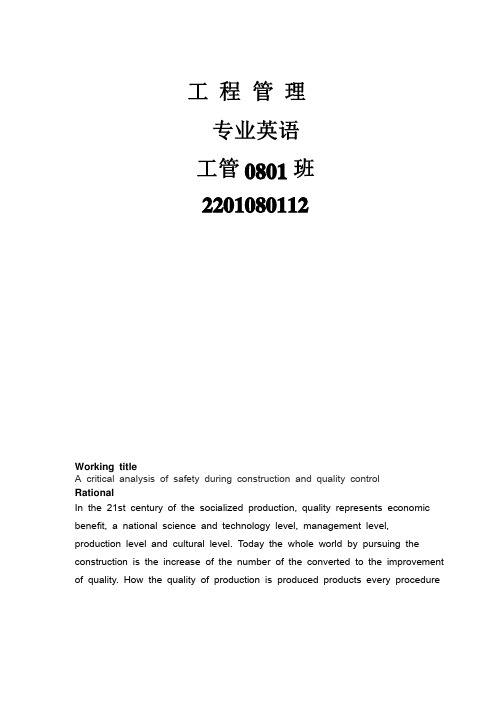
工程管理专业英语工管0801班2201080112Working titleA critical analysis of safety during construction and quality control RationalIn the 21st century of the socialized production, quality represents economic benefit, a national science and technology level, management level, production level and cultural level. Today the whole world by pursuing the construction is the increase of the number of the converted to the improvement of quality. How the quality of production is produced products every procedure execute quality decision, working procedure quality is the final quality foundation and effective guarantee of the production. And the building process is often rather complicated, which the activity is various. According to the "key minority, secondary most" principle of the main and key process do have more controls, which is the eternal theme of the quality work. Safety during construction is the safety questions in the construction industry and maintenance activities. Safety during construction covers all safety issues during the process of working, which involves management, financial and logistics relevant contents. Our government always has heavy production of and formulates safety accidents, the people’s life and property security,relevant laws and regulations, and we established the relevant government agencies within the territory of the People's Republic of China to make a clear requirement in the construction industry of personnel units. Quality control of projects refers to projects to meet quality requirements, that is, in order to guarantee the project quality to meet the project contract, standard series of measures taken, methods and means. Project quality control objectives include the following three aspects: 1. The work of quality control objectives The quality of work are involved in the project refers to the entire process of construction personnel, project construction in order to ensure the quality of job performance level and degree of perfection. The goal of quality control decomposed into: the management of the quality of work, political work quality, technical quality of work and logistics, such as the quality of work of four. 2. Process Quality Control Objectives Construction projects through the entire process together with procedures to be completed. The quality of each process must have to meet the corresponding requirements under the procedures of quality standards, process quality is bound to decide the quality of products. Project quality control objectives Resolvable as: personnel, materials, machinery, construction methods and construction of the environment. 3. Product quality control objectives Engineering product quality refers to the project to meet the relevant standards or contractual requirements, including in the use of functional, safety and durability and environmental protection of all visible and hidden characteristics of the sum of the capacity. Product quality control objectives of the project decomposed into: applicability, safety, durability, reliability, economy and in harmony with the environment, etc. AimTo use the TQM & TQC theory to ensure the quality and safety during construction feasible and be carried out smoothly. ObjectivesTotal quality management principle overview: 1. In "Quality Control" (Quality Control), the phrase "Quality" is a word does not have absolute sense of "best" general meaning. Quality means "the most suitable for certain customer requirements. These requirements are: a. the actual products USES; B. selling price of the product. 2. In "quality control" the phrase, "control" one word said a management tool, including four steps: a. make quality standard, B. the evaluation criteria of executive circumstance; C. deviate standard picked corrective action, D. arrange improve standards of plan. 3. The influence factor of product quality can be divided into two categories: a. technical aspects, namely machines, materials and techniques; B. people aspects, namely the operator, team leader and other company personnel. In these two kinds of factors, human factors are much more important. 4. Total quality management is to provide quality products have never need excellent product design, processing method and serious product maintenance service activities such as a kind of important means. 5. Quality management of the basic principles applicable to any of the manufacturing process, due to the enterprise field, size is different, the use of slightly different, but the basic principle is still the same. Methods the difference can be summarized as: in mass production, quality management focus on the product, in mini-batch production, focus on control procedure. 6. Quality management in industrial production processes throughout all phases. First is to users send product, and for installation and maintenance field service. 7. To effectively controlling influence factor of product quality, must be in production or service process of all main stages try to control. These controlling call quality management work (Job of quality control), according to the nature can be classified into four categories: a. new design control; B. the plant material control, C. product control; D. research projects. 8. Establish quality system is carrying out the work of quality management of one of the most effective ways and means. 9. Quality cost is measured and optimize the overall quality management activity of a kind of means. 10. In organization, total quality management is the upper management department of the tools used to appoint product quality aspect of the authority and responsibility, in order to achieve both from the upper management department chores, and may retain the upper management department to ensure quality results satisfying means purpose. 11. In principle, general manager of the company shall be the work of quality management "chief designer", at the same time, he and other major functional departments should also help the company in efficiency, modernization and quality control of the play. 12. From interpersonal relationship standpoint, quality management organization includes two aspects: a. for relevant staff and departments to provide the quality of the product information and communication channels, B. for relevant departments and employees involved with the quality management work provides means. 13. Quality management work must have the full support of the upper management department. If the upper management department support enough enthusiasm, then, to the company have more publicity within others could not have got the real effect. 14. In total quality management work, no matter when, where, can use mathematical statistical method, mathematical statistics method, but only one of the content of total quality management, it is not equal to the total quality management. 15. Should seriously in the company's scope gradually develop overall quality management activities? It is wise, choose one or two quality subject tries to solve and succeed, then click this way step by step and implement quality management plan. 16. Total quality management work is an important feature of quality control, from the root. For example, by the operator oneself measure to promote and set up his achievements responsibility for product quality and cared for, is the comprehensive quality management work of positive results. Theoretical frameworkTotal quality management this name, the first is the beginning of the 1960s by American famous expert Philip's proposed. Root fort It is the traditional quality management basis, with the development of science and technology and management on the needs of the modernization of the rise and development of quality management, it has now become a door systemic strong science. Norms or rules to achieve the quality requirements of data taken by the operating technologies and measures. That is to say, quality control are adopted in order to monitor the quality of the formation process, the elimination of all stages on the quality of Central India from failed or are not satisfied with the effect of factors. To meet the quality requirements, access to economic benefits and quality of operation with the various technologies and activities. Fields in the enterprise, quality control activities are enterprises within the production site management, it has nothing to do with whether the contract is to achieve and maintain quality control and technical measures and management measures for areas of activity. Quality Inspection subordinate quality control, quality control is important activities. Main hypothesis"Operation "Operation technology" technology" technology" means means means and and and methods methods methods of of of control control control are are are a a a general general general term, term, "Activity" is the operation of these technologies has planned, organized use of the system is a scientific quality management practices. The former emphasis on methods, tools, and the latter focused on the activities of the process. The purpose of quality control to prevent the main factors governing the outcome of security to ensure that requirements, cost-effective implementation. The primary function of quality control is through a series of operating techniques and activities will be a variety of quality variations and to minimize the extent of fluctuations. Wear it in quality, the formation and implementation of the entire process. In addition to controlling product differentiation, quality control department is also involved in management decision-making activities in order to determine the level of quality. Outline methodologyStage : literature review and the pilot study Going Going to to to the the the school school school library library library and and and selecting selecting selecting the the the relevant relevant relevant periodical periodical periodical and and and books, books, surfing the Internet is also the main method of the collection of the information. Proposed structure of dissertationChapter1-Introduction and background to the problemChapter2-Review of the way of quality control Chapter3-Review of the way of safety during constructionChapter4-Find the relation between quality control and safety during constructionChapter5-Give successful examples of the application of TQC Chapter6-Conclusions Chapter7-BibliographyReferences“Project Management for Construction” by Chris Hendrickson.“Construction Nightmares: Jobs from Hell and How to Avoid Them” (2nd edition) by O'Leary, Arthur F., and James Acret.“Project Management: A Managerial Approach” (6th edition) by Meredith, Jack R., and Samuel J. Mantel, Jr.《建筑施工手册》(建筑工业出版社 第四版) 《建筑工程质量管理条例》《工程管理专业英语》建设安全监理实用手册建设安全监理实用手册 徐君伦徐君伦上海社会科学院出版社上海社会科学院出版社建设工程监理安全责任读本建设工程监理安全责任读本 杨效中杨效中 %漆贯学%漆贯学 %陆湛秋%陆湛秋中国建筑工业出版社中国建筑工业出版社建设工程安全监理实务手册建设工程安全监理实务手册 郭劲光郭劲光 %吕方泉%吕方泉中国建材工业出版社中国建材工业出版社建设工程安全监理/建设工程安全技术与管理丛书建设工程安全技术与管理丛书 李世蓉李世蓉 中国大陆%兰定筠中国大陆%兰定筠 中国大陆中国大陆 中国建筑工业出版社中国建筑工业出版社 建筑工程监理资料/建筑工程资料管理系列丛书建筑工程资料管理系列丛书 北京土木建筑学会北京土木建筑学会 经济科学出版社经济科学出版社工程监理·安全监理·项目管理规范化操作手册项目管理规范化操作手册 黄金枝黄金枝 %刘永新%刘永新 中国建筑工业中国建筑工业施工项目管理(高等职业教育建筑工程技术专业技能型系列教材) 韩国平韩国平 东南大学出版社东南大学出版社。
工程项目管理的英语论文
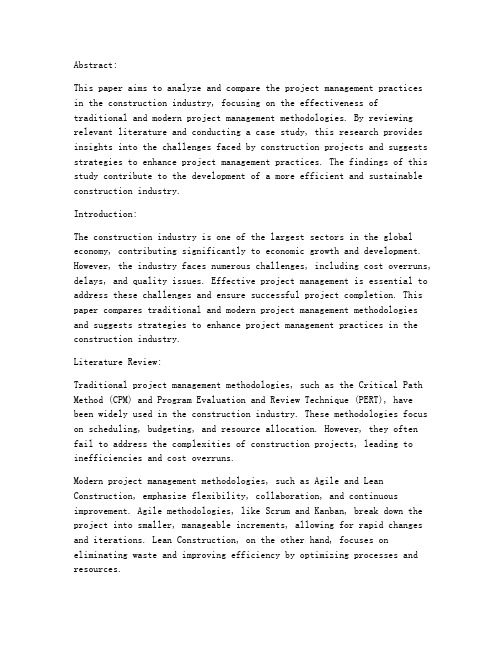
This paper aims to analyze and compare the project management practices in the construction industry, focusing on the effectiveness oftraditional and modern project management methodologies. By reviewing relevant literature and conducting a case study, this research provides insights into the challenges faced by construction projects and suggests strategies to enhance project management practices. The findings of this study contribute to the development of a more efficient and sustainable construction industry.Introduction:The construction industry is one of the largest sectors in the global economy, contributing significantly to economic growth and development. However, the industry faces numerous challenges, including cost overruns, delays, and quality issues. Effective project management is essential to address these challenges and ensure successful project completion. This paper compares traditional and modern project management methodologies and suggests strategies to enhance project management practices in the construction industry.Literature Review:Traditional project management methodologies, such as the Critical Path Method (CPM) and Program Evaluation and Review Technique (PERT), have been widely used in the construction industry. These methodologies focus on scheduling, budgeting, and resource allocation. However, they often fail to address the complexities of construction projects, leading to inefficiencies and cost overruns.Modern project management methodologies, such as Agile and Lean Construction, emphasize flexibility, collaboration, and continuous improvement. Agile methodologies, like Scrum and Kanban, break down the project into smaller, manageable increments, allowing for rapid changes and iterations. Lean Construction, on the other hand, focuses on eliminating waste and improving efficiency by optimizing processes and resources.To illustrate the effectiveness of these methodologies, a case study was conducted on a construction project. The project involved the construction of a residential complex, and the study compared the traditional CPM methodology with the Agile and Lean Construction methodologies.Results:The results of the case study indicated that the Agile and Lean Construction methodologies significantly improved project performance compared to the traditional CPM methodology. The Agile methodology allowed for rapid changes and iterations, leading to shorter project durations and reduced costs. Lean Construction, on the other hand, helped eliminate waste and improve resource allocation, resulting in higher quality outcomes.Discussion:The findings of this study suggest that modern project management methodologies, such as Agile and Lean Construction, can enhance project management practices in the construction industry. These methodologies emphasize flexibility, collaboration, and continuous improvement, which are essential for addressing the complexities of construction projects.Conclusion:In conclusion, this paper compares traditional and modern project management methodologies in the construction industry and suggests strategies to enhance project management practices. The case study results demonstrate the effectiveness of Agile and Lean Construction methodologies in improving project performance. By adopting these methodologies, the construction industry can achieve greater efficiency, cost savings, and quality outcomes.Keywords: Project management, construction industry, Agile, Lean Construction, traditional methodologies, case study。
工程管理英文作文
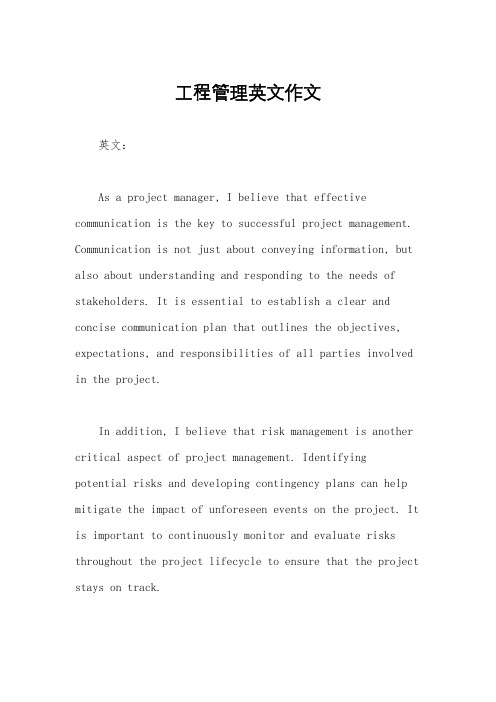
工程管理英文作文英文:As a project manager, I believe that effective communication is the key to successful project management. Communication is not just about conveying information, but also about understanding and responding to the needs of stakeholders. It is essential to establish a clear and concise communication plan that outlines the objectives, expectations, and responsibilities of all parties involved in the project.In addition, I believe that risk management is another critical aspect of project management. Identifyingpotential risks and developing contingency plans can help mitigate the impact of unforeseen events on the project. It is important to continuously monitor and evaluate risks throughout the project lifecycle to ensure that the project stays on track.Furthermore, I think that leadership is a crucial skill for project managers. A good leader should be able to inspire and motivate team members to achieve their best performance. They should also be able to make tough decisions when necessary and provide guidance and support to team members.To illustrate, I once managed a construction project where communication was a challenge due to languagebarriers between the project team and the client. To overcome this, I established a communication plan that included regular meetings with the client and translated project documents. Additionally, I identified potential risks such as weather delays and developed contingency plans to ensure that the project stayed on schedule. Finally, I provided leadership by motivating the team to work together and achieve the project objectives.中文:作为项目经理,我认为有效的沟通是成功的项目管理的关键。
工程管理专业 英文 作文
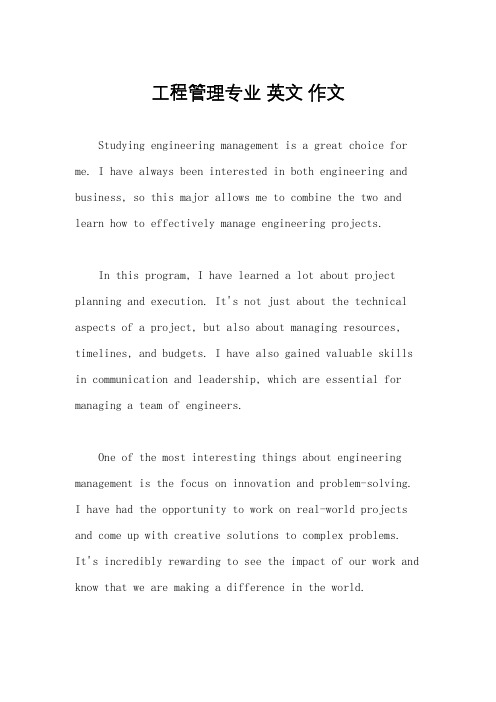
工程管理专业英文作文Studying engineering management is a great choice for me. I have always been interested in both engineering and business, so this major allows me to combine the two and learn how to effectively manage engineering projects.In this program, I have learned a lot about project planning and execution. It's not just about the technical aspects of a project, but also about managing resources, timelines, and budgets. I have also gained valuable skills in communication and leadership, which are essential for managing a team of engineers.One of the most interesting things about engineering management is the focus on innovation and problem-solving.I have had the opportunity to work on real-world projects and come up with creative solutions to complex problems.It's incredibly rewarding to see the impact of our work and know that we are making a difference in the world.Another important aspect of this major is learning about risk management. In any engineering project, there are potential risks that need to be identified and mitigated. I have learned how to assess risks and develop strategies to minimize their impact on the project.Overall, studying engineering management has been a challenging but rewarding experience. I have developed a wide range of skills that will be valuable in my future career, and I am excited to see where this major will take me.。
工程项目管理论文英语
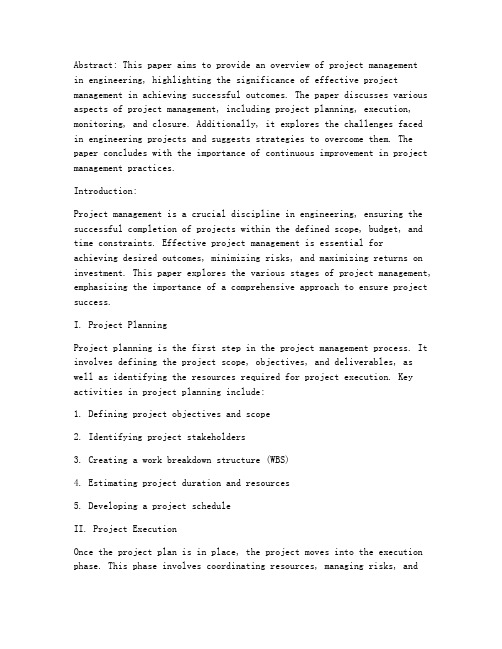
Abstract: This paper aims to provide an overview of project managementin engineering, highlighting the significance of effective project management in achieving successful outcomes. The paper discusses various aspects of project management, including project planning, execution, monitoring, and closure. Additionally, it explores the challenges faced in engineering projects and suggests strategies to overcome them. The paper concludes with the importance of continuous improvement in project management practices.Introduction:Project management is a crucial discipline in engineering, ensuring the successful completion of projects within the defined scope, budget, and time constraints. Effective project management is essential forachieving desired outcomes, minimizing risks, and maximizing returns on investment. This paper explores the various stages of project management, emphasizing the importance of a comprehensive approach to ensure project success.I. Project PlanningProject planning is the first step in the project management process. It involves defining the project scope, objectives, and deliverables, as well as identifying the resources required for project execution. Key activities in project planning include:1. Defining project objectives and scope2. Identifying project stakeholders3. Creating a work breakdown structure (WBS)4. Estimating project duration and resources5. Developing a project scheduleII. Project ExecutionOnce the project plan is in place, the project moves into the execution phase. This phase involves coordinating resources, managing risks, andexecuting the project activities as per the plan. Key aspects of project execution include:1. Assigning tasks and responsibilities to team members2. Implementing project control measures3. Monitoring project progress4. Managing project risks and issues5. Ensuring quality controlIII. Project Monitoring and ControlProject monitoring and control involve tracking project progress, identifying deviations from the plan, and taking corrective actions. This phase ensures that the project remains on track and meets its objectives. Key activities in this phase include:1. Collecting project performance data2. Comparing actual performance with the plan3. Identifying deviations and causes4. Taking corrective actions5. Documenting lessons learnedIV. Project ClosureThe final phase of project management is project closure. This phase involves completing all project activities, obtaining client approval, and ensuring the successful transition of deliverables. Key activities in project closure include:1. Verifying project completion2. Obtaining client approval3. Conducting project review meetings4. Documenting project closure5. Celebrating project successChallenges in Engineering ProjectsEngineering projects often face various challenges, such as:1. Scope creep2. Resource constraints3. Time pressure4. Technological uncertainties5. Communication barriersStrategies to Overcome ChallengesTo overcome these challenges, project managers can adopt the following strategies:1. Clear communication and stakeholder engagement2. Effective risk management3. Robust change management processes4. Continuous monitoring and control5. Leveraging technology and toolsConclusionProject management in engineering is a complex and dynamic process. A comprehensive approach to project management ensures successful project outcomes, minimizing risks, and maximizing returns on investment. By effectively managing the various stages of the project lifecycle,project managers can deliver high-quality deliverables and foster client satisfaction.Keywords: project management, engineering, project planning, project execution, project monitoring and control, project closure, challenges, strategies。
工程管理英语大作文

工程管理英语大作文The Essence of Engineering Management.Engineering management, a discipline that blends the technical know-how of engineering with the managerialskills of organization and leadership, is crucial intoday's rapidly advancing technological landscape. It involves the planning, design, implementation, and supervision of engineering projects, ensuring theirefficient execution and timely completion. This article delves into the intricacies of engineering management, exploring its significance, challenges, and future prospects.The Importance of Engineering Management.Engineering management plays a pivotal role in the success of any engineering project. It ensures that the project is carried out efficiently, effectively, and within budget. The engineering manager is responsible for leadinga team of engineers and other professionals, coordinating their efforts, and ensuring that the project meets its objectives.The role of the engineering manager extends beyond mere supervision. They must possess a deep understanding of the technical aspects of the project, while also having the ability to manage people, resources, and time. They must be adept at problem-solving, decision-making, and risk management, skills that are crucial in navigating the complexities of engineering projects.Challenges in Engineering Management.Engineering management presents its own unique set of challenges. One of the most significant challenges is managing the diverse team of professionals involved in a project. Engineering projects often involve a mix of engineers, architects, designers, contractors, and other specialists, each with their own area of expertise and working styles. The engineering manager must be able to bring these individuals together, fostering a collaborativeenvironment where everyone can contribute effectively.Another challenge lies in managing the ever-changing technological landscape. Technology is constantly evolving, and engineering managers must keep themselves abreast of the latest advancements to ensure that their projects are up-to-date and competitive.Furthermore, engineering projects often involve strict deadlines and budgets. Managing these constraints while ensuring the quality of the project can be a daunting task. Engineering managers must have excellent planning and organizational skills to balance these competing demands.Future Prospects of Engineering Management.Despite the challenges, the future of engineering management looks bright. With the continuous advancement of technology and the increasing complexity of engineering projects, the need for skilled engineering managers is likely to grow.The emergence of new technologies such as artificial intelligence, robotics, and the Internet of Things is expected to transform the engineering landscape. Engineering managers will need to adapt to these changes, leveraging technology to improve project efficiency and effectiveness.Additionally, the increasing globalization of the engineering industry presents new opportunities for engineering managers. Projects are no longer confined to a single country or region; they often involve teams from different cultures and backgrounds. Engineering managers who possess strong leadership and communication skills will be well-positioned to capitalize on these global opportunities.Conclusion.Engineering management is a crucial discipline thatlies at the heart of any successful engineering project. It requires a unique blend of technical knowledge, managerial skills, and leadership abilities. As the engineeringindustry continues to evolve and expand, the role of engineering managers will become even more important. By staying abreast of the latest trends and technologies, and fostering a collaborative and innovative culture, engineering managers can help their teams deliver projects that are not only technically sound but also contribute positively to society.。
工程管理前沿英文作文
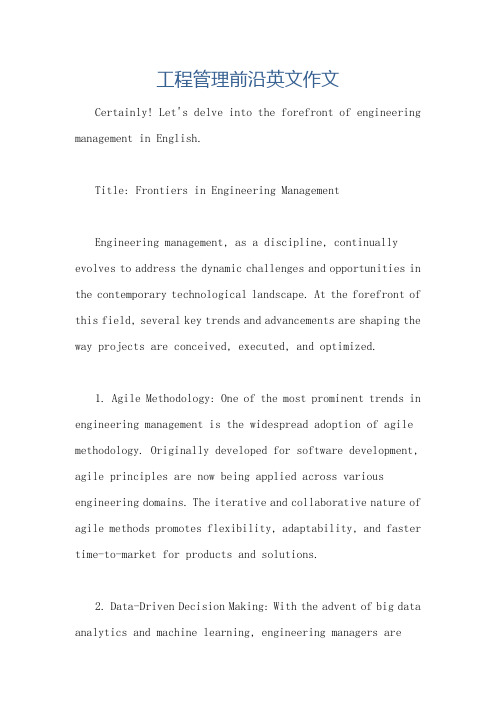
工程管理前沿英文作文Certainly! Let's delve into the forefront of engineering management in English.Title: Frontiers in Engineering ManagementEngineering management, as a discipline, continually evolves to address the dynamic challenges and opportunities in the contemporary technological landscape. At the forefront of this field, several key trends and advancements are shaping the way projects are conceived, executed, and optimized.1. Agile Methodology: One of the most prominent trends in engineering management is the widespread adoption of agile methodology. Originally developed for software development, agile principles are now being applied across various engineering domains. The iterative and collaborative nature of agile methods promotes flexibility, adaptability, and faster time-to-market for products and solutions.2. Data-Driven Decision Making: With the advent of big data analytics and machine learning, engineering managers areincreasingly relying on data-driven insights to make informed decisions. By harnessing the power of data analytics, project managers can optimize resource allocation, predict project risks, and identify areas for improvement with greater precision.3. Sustainable Engineering Practices: In response to growing environmental concerns, sustainability has emerged as a critical consideration in engineering management. From green building design to renewable energy projects, there is a growing emphasis on integrating sustainable practices throughout the project lifecycle. Engineering managers are tasked with balancing economic objectives with environmental and social responsibility.4. Digital Transformation: The digital transformation wave is revolutionizing engineering management processes and workflows. Technologies such as Building Information Modeling (BIM), Internet of Things (IoT), and Artificial Intelligence (AI) are driving efficiency gains, enhancing collaboration, and enabling predictive maintenance in engineering projects. Embracing digital tools is essential for staying competitivein today's fast-paced business environment.5. Cross-Disciplinary Collaboration: As engineering projects become increasingly complex, collaboration across different disciplines is becoming indispensable. Engineering managers must foster interdisciplinary teamwork, bringing together experts from engineering, finance, marketing, and other fields to tackle multifaceted challenges holistically. Effective communication and leadership skills are paramount in orchestrating such cross-disciplinary collaboration efforts.6. Risk Management and Resilience: With the rise of global disruptions, such as pandemics and climate change-related events, engineering managers are reevaluating risk management strategies to enhance project resilience. From supply chain disruptions to cybersecurity threats, proactive risk mitigation and contingency planning are essential for ensuring project success in an uncertain world.7. Ethical Considerations: Ethical considerations are gaining prominence in engineering management discussions, particularly concerning emerging technologies like AI,autonomous systems, and genetic engineering. Engineering managers are grappling with ethical dilemmas related to privacy, safety, and equity, requiring a nuanced approach todecision-making that prioritizes ethical principles alongside technical objectives.In conclusion, engineering management is at the forefront of innovation and change, driven by a confluence of technological advancements, societal demands, and global challenges. By embracing agile methodologies, leveraging data-driven insights, prioritizing sustainability, embracing digital transformation, fostering cross-disciplinary collaboration, enhancing risk management practices, and upholding ethical standards, engineering managers can navigate the complexities of the modern landscape and lead their teams to success.。
工程管理英文文献#精选

Engineering supervision system in China's Engineering constructionin the positionWith the dominance of China's socialist market economy, the determination of the project supervision system in China's highway construction is gradually becoming more mature. Talking about the project in the country, people always focus on project quality side, it seems that the focus of the task of supervision is to protect the quality of projects, in fact, it is very comprehensive, according to FIDIC provisions in the project construction, project quality, of course, crucial, but only to protect the project supervision of the three objectives (quality, duration, cost), one of these three goals are interrelated and influence, from different angles to protect the owners of the project efficiency. Of which cost control is also very important to the management aspect of this work, good or bad, is directly related to whether the quality of the project can achieve the desired goals, and whether the progress can be completed on time.First, the design phase of the design phase of SupervisionThe introduction of engineering supervision, determine a reasonable design, mature technology, reduce the construction phase of major design changes and program changes to occur, the effective cost control will play a certain role. Experts say: If the project supervision involved in the design stage, then, and can be ruled out, to correct 80% of the errors, but to the construction stage to be involved in supervision of works, at best, can only save 20% of the investment. According to the information briefing, a German university laboratory building, the original design is three and a basement, the project management company to meet the commission's space requirements and functional conditions, proposed to increase the layer to shorten the two-axis then the abolition of the basement. But also reduces the flow of people to evacuate distance (to the required standards), so modified after the design is not only reduced costs, has also been improved functionality, access to credit and praise of the municipal government. At present, China for engineering supervision at the design stage to introduce the practice is still rare, we should learn from foreign countries mature and developed system, the development of relevant systems, and standardize the market. Advocates strengthening the design phase of the supervision, control and management from a cost sense, ex ante control, prevention, which is scientific and reasonable. Therefore, to enhance the design stage to control the cost ofsupervision is necessary.Second, the construction phase of the SupervisionAs we all know, domestic and international construction markets are the dominant owners of a buyer's market, the construction of competition among enterprises is very cruel. In order to bid, bidders tend to almost zero profits or even below cost bids, but the owners often use low-cost way of winning. While the bidders promised to abide by the provisions of contract documents, but once the contract, they refused to the end there is no profit or losing money, so, often with inferior materials, do not follow standard construction, bribery, or layers of subcontracting means to profit. This time, the absence of an effective supervision mechanism, the victims can only be the owners.From the process, process control the cost of supervision of supervision engineer should not only be concerned with whether the works to meet the required quality goals, he should be the focus all the objectives of the project design, in the actual operation, the contractor engaged in construction prior to permanent per days must be carried out by a variety of inspection, testing, content or face a new job, workload, construction methods, measures, materials testing and sub-contracting part of the work or works submitted to the approval of supervisory engineer. The contractor can only work within the approved, without approval or beyond the approved engineer's work can not be recognized. At the same time is also an engineer approved the contractor to obtain a basis for progress payments. Engineers, contractors, any non-approved inputs (manpower, materials, equipment) will not receive compensation, meaning that there is no engineer's approval, the contractor shall not proceed to the next one process or face, shall not be put into construction materials, use, shall not subcontract part of the project or work.Supervision and Control of project cost from the cost of the engineering supervision of the project cost management goal is to project to be completed within the contract price can not be there far exceed estimates. Supervision of the strict monitoring of the project, due to the contractor causes the possibility of super-budget is almost zero. This is because: Engineering Super-budget, no more than two kinds of reasons, the first rise in unit labor and materials, first, during the construction works increased volume, while the contractor's bid is a commitment to its binding, and the contractor not entitled to their own works to increase the amount of the project, even if there are engineers, required the contractor to increase the input of resources toprotect the project design goals, the contractor has no right to be compensated, therefore, because in the tender document, the contractor can protect a large number of frequently cited the successful completion of the project personnel and mechanical equipment. From equipment costs, materials costs and equipment costs control supervision, materials costs in the capital projects account for about 70% of the entire cost. It is the project a major component of direct costs. Materials, equipment, high and low prices will directly affect the size of the construction costs.Thus, in the supervision process, can not be ignored that part. To introduce competition, and create competitive conditions. Owners can delegate the direct supervision through public tender selecting the suppliers, so that contractors can avoid unauthorized lower prices, delays in provider payments and thus lead to shoddy supplier, delivery is not timely, thereby affecting the progress of projects happening. The contractor in the preparation of tender prices, mainly the prices of materials and equipment owners and suppliers signed price quotation, by the suppliers of materials and equipment will be mainly transported to the scene by the supervising engineers and contractors to co-sign, the by the owner will focus on the procurement of materials and equipment shall be paid directly to suppliers.From the above procedures is easy to see the contractor in addition to supervising engineers no choice but to obey. This is because the supervising engineer contractor performance has a strong economic constraints means, economic means of payment by the project system and the deposit system, composition, they are the heads of the two contractors, "inhibition".The project payment system: in fact, the project payment system is to project the economic risk of being transferred to the contractor. Contractor must obtain economic benefits (the bid price and the difference between the actual cost of the project) prior advance money or other resources, that is: He had to buy the materials, equipment, payment of wages and other expenses, under the supervision of the supervising engineer contract documents all requests to create a project. Can only be the work of the contractor to complete the written approval of the supervisory engineer and the quality of bond, after deducting there from the owner to obtain compensation (for projects). If the contractor's work should not be so satisfied with supervision, he not only no hope of profit, and even the cost of inputs can not be recovered.Project Margin System: As a rule, signed contract before the contractor must pay the contract price equal to 10% of the performance bond or letter of guarantee. Thecontractor prior to commencement of course, can be obtained from the owners of 10% of the total contract price of the advance payment, but he must also be matched to the owners to submit a bond or letter of guarantee. Even if the contractor has received final acceptance certificates from the project, he will be leaving 5% of total contract price of the retention money. Here the performance bond and retention payments totaling 15% of the project contract price, far greater than the contractor's profit margin. The contractor's default can cause bond be forfeited, and whether the breach of contract only to evaluate the supervisory engineer.Third, completion of the project closing of SupervisionThe first job done in several stages, based on the completion of settlement on a lot easier. Labor Exchange acceptance of the project handled immediately after completion of billing processing. Completion of the contract price settlement value is value of claims already liquidated damages.According to FIDIC terms or model of China's construction contract terms and the actual text of the provisions of the terms of the contract is signed: involving construction claims and breach of contract issues, supervision engineers must clearly define the responsibilities to minimize the claims, to reduce the claim should note the following: strengthening contract management, improve the terms of the contract; before projects should be fully prepared to work; enhance the design of the review, the timely detection of problems in the design to avoid the construction.Engineering design changes due to claims arising; to strengthen quality management, and strengthen the quality of tracking, to avoid or reduce the contract sample tests or works outside the review of claims arising; to improve the quality of supervision engineers found that claims in a timely manner.In short, the supervision engineer in Cost Control of the importance of the role and status is beyond question, supervision is entrusted by the owners on the implementation of the project to conduct supervision and management, reform and opening up of China's foreign towards WTO needs. Project Management is a need for a variety of professional and technical, economic, legal and other integrated management of multi-disciplinary knowledge and skills in intellectual-intensive service work, which requires supervisors controlling costs, management contracts and information, the ability to mediate economic disputes, continually improve their own quality, and enhance awareness of contract management, improve the legal system. To this end, the state unit of the Ministry of Construction Supervision of social hierarchyand the corresponding conditions and qualification standards, supervision of qualified engineers to make separate provision accordingly. Project Management in China has generally been carried out, as a mature project management experience in the management of cost control will certainly play a key role.最新文件仅供参考已改成word文本。
工程管理英语论文

工程管理英语论文工程管理专业英语Working Title:Contract management of construction projectClass:Name:Number:Working titleA critical analysis of contract management of construction project. Purpose of studyContract management is an important part of project management, engineering project management through the whole process, not only determine the price of the project construction period, objectives, the quality objectives, obligations and responsibilities, and contract management is other project management system of work instructions, and the engineering project management played the overall control function. In the fierce market competition, the construction enterprise in order to be able to win the bid to get at the low success, however low quoted price behind success is the management level of the enterprise competition. At the same time due to construction enterprise as a contractor often and in a relatively passive position in the whole process of construction of the project are often natural conditions and social factors, such as the unforeseen factors, lead to risk all may happen at any time, it is for the existence of the objective factors and uncertainty, construction enterprises must improve the level of management, enhance the contract management consciousness. No contract management is no management goal, no management goal will not project management system forming, of course, will be difficult to achieve .The project management profit objectives, and even cause project paralyzed, unable to operate.Contract management is serviced for the goal of the project and the general target of the enterprise, to ensure to achieve them. Specifically, contract management includes:(1) The whole project in the planned cost (investment), to complete the project within a predetermined range, meet the quality and function ofpredetermined requirements, implementation of the three objectives ofthe project.(2) The implementation of the project smoothly, the contract dispute is less, the contract can coordinate with each other, are able to perform the contract responsibility successfully.(3) To ensure that the entire project contract signing and implementation process meets the requirements of the law.(4) A successful contract management, but also at the end of the work that was satisfactory to both parties, the owners get a qualified project, achieve the investment objective, on the project, the contractor, feel the cooperation of both sides satisfied; the contractor not only obtain the reasonable price and profit, but also won a reputation, to establish the friendly and cooperative relations. This is the requirements what the enterprise management and the development strategy need the contract management to do.AimTo use the theory to ensure the project can be carried out smoothly Objectives1)ObjectiveMacroscopically, the objective of the contract management is to strengthen supervision and management of construction activities, maintain the market order,guarantee quality and safety of the project,simulative construction industry health develops, To provide a legal basis for every part of a project,at the same time, will definitely provide usefulhelp to construction industry to take an active role in the international standardization activities。
工程项目管理英文版论文
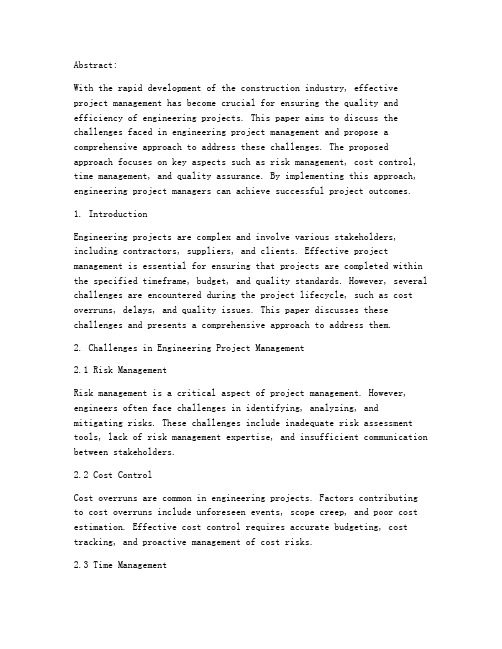
Abstract:With the rapid development of the construction industry, effective project management has become crucial for ensuring the quality and efficiency of engineering projects. This paper aims to discuss the challenges faced in engineering project management and propose a comprehensive approach to address these challenges. The proposed approach focuses on key aspects such as risk management, cost control, time management, and quality assurance. By implementing this approach, engineering project managers can achieve successful project outcomes.1. IntroductionEngineering projects are complex and involve various stakeholders, including contractors, suppliers, and clients. Effective project management is essential for ensuring that projects are completed within the specified timeframe, budget, and quality standards. However, several challenges are encountered during the project lifecycle, such as cost overruns, delays, and quality issues. This paper discusses these challenges and presents a comprehensive approach to address them.2. Challenges in Engineering Project Management2.1 Risk ManagementRisk management is a critical aspect of project management. However, engineers often face challenges in identifying, analyzing, andmitigating risks. These challenges include inadequate risk assessment tools, lack of risk management expertise, and insufficient communication between stakeholders.2.2 Cost ControlCost overruns are common in engineering projects. Factors contributing to cost overruns include unforeseen events, scope creep, and poor cost estimation. Effective cost control requires accurate budgeting, cost tracking, and proactive management of cost risks.2.3 Time ManagementTime management is crucial for ensuring that projects are completed on schedule. However, delays can occur due to various reasons, such as inadequate planning, resource constraints, and poor coordination between project stakeholders.2.4 Quality AssuranceQuality assurance is essential for maintaining the integrity and functionality of engineering projects. However, quality issues may arise due to inadequate design, poor construction practices, or insufficient quality control measures.3. Comprehensive Approach to Engineering Project Management3.1 Risk ManagementTo address risk management challenges, project managers should:- Implement a robust risk management framework that includes risk identification, analysis, and mitigation strategies.- Utilize risk assessment tools and techniques to identify potential risks early in the project lifecycle.- Foster effective communication between stakeholders to ensure a shared understanding of risks and mitigation strategies.3.2 Cost ControlTo control costs, project managers should:- Conduct thorough cost estimation and budgeting to ensure accurate financial planning.- Monitor cost expenditures regularly and take corrective actions to prevent cost overruns.- Implement cost control measures, such as value engineering and alternative procurement strategies.3.3 Time ManagementTo manage project time effectively, project managers should:- Develop a comprehensive project schedule that includes all project activities and milestones.- Allocate resources efficiently to avoid resource conflicts and ensure timely completion of tasks.- Implement change management processes to address schedule deviations promptly.3.4 Quality AssuranceTo ensure project quality, project managers should:- Implement a robust quality management system that includes quality planning, control, and improvement processes.- Conduct regular inspections and audits to identify and rectify quality issues.- Foster a culture of quality within the project team to ensure adherence to quality standards.4. ConclusionEffective project management is essential for the success of engineering projects. By implementing a comprehensive approach that addresses challenges related to risk management, cost control, time management, and quality assurance, project managers can achieve successful project outcomes. This paper provides a framework for project managers to enhance their skills and ensure the successful completion of engineering projects.。
工程项目管理的论文英文
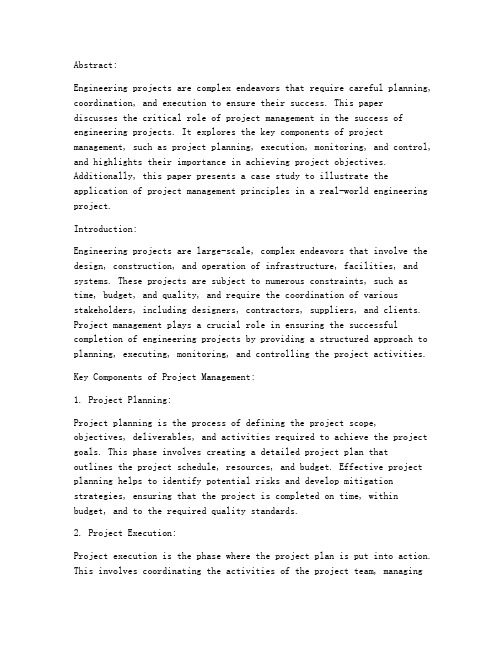
Abstract:Engineering projects are complex endeavors that require careful planning, coordination, and execution to ensure their success. This paperdiscusses the critical role of project management in the success of engineering projects. It explores the key components of project management, such as project planning, execution, monitoring, and control, and highlights their importance in achieving project objectives. Additionally, this paper presents a case study to illustrate the application of project management principles in a real-world engineering project.Introduction:Engineering projects are large-scale, complex endeavors that involve the design, construction, and operation of infrastructure, facilities, and systems. These projects are subject to numerous constraints, such as time, budget, and quality, and require the coordination of various stakeholders, including designers, contractors, suppliers, and clients. Project management plays a crucial role in ensuring the successful completion of engineering projects by providing a structured approach to planning, executing, monitoring, and controlling the project activities.Key Components of Project Management:1. Project Planning:Project planning is the process of defining the project scope, objectives, deliverables, and activities required to achieve the project goals. This phase involves creating a detailed project plan thatoutlines the project schedule, resources, and budget. Effective project planning helps to identify potential risks and develop mitigation strategies, ensuring that the project is completed on time, within budget, and to the required quality standards.2. Project Execution:Project execution is the phase where the project plan is put into action. This involves coordinating the activities of the project team, managingresources, and ensuring that the project deliverables are produced according to the plan. Effective project execution requires strong leadership, communication, and collaboration skills to keep the project on track and address any unforeseen issues that may arise.3. Project Monitoring and Control:Project monitoring and control involve tracking the progress of the project, comparing it to the project plan, and taking corrective actions when necessary. This phase ensures that the project remains on schedule, within budget, and meets the required quality standards. Key performance indicators (KPIs) are used to measure the project's progress, and variance analysis techniques are employed to identify and address any deviations from the plan.4. Project Closure:Project closure is the final phase of the project management process, where the project deliverables are delivered to the client, and the project is formally closed. This phase involves documenting the project outcomes, conducting a post-project review, and celebrating theproject's success. Effective project closure helps to capture lessons learned and improve future project performance.Case Study: Application of Project Management Principles in a Real-World Engineering ProjectThis paper presents a case study of a real-world engineering project to illustrate the application of project management principles. The project involved the construction of a new highway, which was subject to numerous constraints, such as tight timelines, budget limitations, and environmental concerns. The project team employed a structured project management approach, including project planning, execution, monitoring, and control, to ensure the successful completion of the project.The project planning phase involved identifying the project scope, objectives, and deliverables, as well as developing a detailed project schedule, budget, and risk management plan. During the project execution phase, the project team coordinated the activities of variousstakeholders, managed resources effectively, and addressed any unforeseen issues that arose. The project monitoring and control phase involved tracking the project's progress, comparing it to the plan, and taking corrective actions when necessary. Finally, the project closure phase involved delivering the project deliverables to the client, conducting a post-project review, and celebrating the project's success.Conclusion:Project management plays a crucial role in the success of engineering projects. By implementing a structured approach to planning, executing, monitoring, and controlling project activities, project managers can ensure that projects are completed on time, within budget, and to the required quality standards. This paper highlights the importance of project management in engineering projects and presents a case study to illustrate the application of project management principles in a real-world context.。
[工程管理论文(英文)] 工程管理专业论文
![[工程管理论文(英文)] 工程管理专业论文](https://img.taocdn.com/s3/m/847751084b7302768e9951e79b89680203d86bd7.png)
[工程管理论文(英文)] 工程管理专业论文 Modern engineering project have a tendency to develop into large scale andmodern with the complexity of project increase exponentially, only manage and control strictly, the quality and schedule of construction can be guaranteed under the condition of growing investments.Therefore, modern project management mode of “Make detailed planning comprehensively, according to plan strictly, feedback and update timely, track and contrast closely” can’t carry out only through manual lab, only using computer business management system and simple computer network manage pattern also can ’t meet the actual managedemand. On this basis, we think that modern construction project management enterprise to realize modern management model need shifting to intellective management enterprise, establishing the theory and practice framework of enterprise knowledge management combined with computer, knowledge will become the sword of management.Since the reform and opening-up, the numbers of China construction enterprise have increasing rapidly, but from the actual situation there is a gap between China and international in ability to construction project management, which affects the project management level in China. And the quality of project is an important indicator of project management, Therefore, reforming traditionalproject management model and improve the quality of quality have became import issue of construction enterprises. The construction industry is one of basic industries in our country, its normal operation related to the sustained development of the national economy directly. In recent years, with the development of market economy have been establishedand perfected gradually in China, the construction industry has got an unprecedented improvement. Meanwhile, the rapid development has exposed many problems, the construction project quality, especially the residential construction quality, has became the focus of attention. Engineering projects as construction projectproducts invests and consumes much manual lab, material and energy, construction project quality related to engineering applicability and safeties of lives and property of people. On the other hand, it’s related to the survival of enterprises, so the quality management on the top position is imperative.Construction project item management is a one-time comprehensive management and control to optimizing the goal with target, goal and content based on specific construction projects. Its connotation is: from the project start to finish, reaching the goal of quality, rate of progress, cost and safety through the project planning and project control. In view of the constructionproject is disposable, in order to save investment, achieve the goal of energy-saving emission and construction target, and build construction products in accordance with the requirements, we construction personnel must be aware of the importance of project management in the construction process, and pay attention to reinforcing the following aspects in the construction project management in particular case.(I) Quality managementQuality is the life of enterprises and the fundamental guarantee for the development of enterprises. Today, construction market competition has more and more intense. How to improve the quality of the construction management level isevery enterprise managers need to think about.(i) Regime of quality supervision The quality management of the construction project can be summarized by the following words: set goals and clear the lines of responsibility; assign and put it into effect, explain in detail; contra posing the difficulty organizes research; set an example and explore experiences; tracking control and control strictly, do a good job of quality control and regular monitor of the quality of products. Establishing and improving the system of whole process quality monitoring, intervening and controlling project quality through scientific method, means and control mechanism to let the project quality always in a dynamic management.① Establish the system of quality self-checking. The quality of project involves all aspects of society, and also reflects the level of enterprises management synthetically. In general, any construction project should accept supervision from the enterprises itself. Enterprises self-checking require any construction company establish a effective system of quality supervision, and through the run of this system to improve quality continuously.② Quality supervision by the third-party. It means enterprises shouldaccept the supervision by owner, and the type of supervision is the most authoritative now. These two types of quality supervision in above workclearly, communicate closely and compose to the complete system of control construction project quality, so that enterprises can promise project quality achieve desired expect.(ii) The supervision methods and meansAs an administrative staff, controlling the quality of engineeringconstruction is the most important thing inlocale management. Whether the quality of projectis good or bad depends on the management level of inspector and the supervision.① The site supervision in each process of construction operation shouldfound the problem on-site, point out and correct, use the methods measure honestly combined withoverall look-and-feel.② Call all on-site management personnel together to specify thecommon problem in the construction process, have a in-depth knowledge to construction workers, and correct mistakes timely.③ Write the book of quality control and guidance document. For those quality problems may occur or has occurred, we management personnel should do an introduction and countermeasures in detail, clear responsibility and claim related personnel correct on time.(II) Schedule management Whether the project can be delivered within agreed timeframe have a direct influence on the development of project economicand social effect results benefit. The factor of human, technology, material, equipment, machine, foundation, funds, climate and environment all affect the process of project schedule. In order to do a good schedule management of project, we need solving the following problems focused.① Establish the pattern and framework of project management. A successful project must have a successful management team and a standard work mode, operating procedures and business system.② Establish a strict contract network system. A large project is acommunity consists of many construction workers, so it needs a strict contract system to mobilize the enthusiasm of all people so that can avoidsabotage and wrangling each other.③ Develop a practical project plan of three grades. This plan requires not only the work of construction organization, but also the work of owners, design company and supervision company, what’s more, we should take government which very relative to construction into consideration.④ Determine the design company, sign the design contract and thecheck and review of design quality and speed. Whether the project construction can be carried out smoothly depends on the quality of design.⑤ The bids and evaluation of construction organization, the sign ofconstruction contract, including the choicebetween general contractor and sub-contractors, and sign the contract of support of material and equipment.⑥ Handle government formalities in earlier stage project plan andarrange the municipal auxiliary projects. Sufficient communication with government and good relationship are promise to successful project. (III) Cost controlThe type of Construction project cost is divided into the budgetcost, plan cost and actual cost. Under the situation of construction cost meet schedule and quality, through the methods of origination, economics, technology and contracts to control thecost in the range of expect. To tighten the project cost management, we can undertake it in the following aspects:① The enterprises should formulate the work quota, and those money should use according to engineering quantities, and we should calculate the total quantities of manmade. We can control the manmade cost as long as control the manmade quantities so that control the project cost.② Strengthen material management, establish the system of limits of material requisition, manage the material out of storage strictly, lump sum to those material cost much in site.③ Improve the utilization rate of equipment and materials. Check on,repair and maintain the construction machine regularly, rented equipment and material should return to rent company on time to speed up the construction period and reduce the rent cost.④ Choose a correct construction scheme is the key to shorten theconstruction period, improve quality and reduce the cost, in the process of construction, we should try our best to search new techniques, new technology, new materials to r educe costs, improve efficiency.⑤ Be strict in construction: construction inline with the drawings and the standard, be strict in quality to ensure project quality, reduce the waste of labor and material caused by rework.⑥ Streamline the management mechanism, reduce the level of management to save the construction management fees. (IV) Security managementSafety production management of construction projects –organize all activities of production safety, through the control of production factors to reduce or eliminate unsafe behavior and state, does not cause the accident, so as to the normal operation of construction project.① Adhere to principle of security management. Safety and production are synchronous so that if control the production safety also should be controlled, safety contain in the production,what ’s more, promote and promise the production. Safe working is common thing of anyone relativewith production rather than only relative with minority and security mechanism, lack of full participation, securitynot obvious.② Adhere to control the unsafe behaviors of human and unsafe states of things. From the analysis of the causes of the accident, we can get that human, things and environment is the fundamental reason of accident. From the human and things management sides to analyze accident, unsafe human behaviors and unsafe things states are both fundamental reason of accident.③ Establish safety management measures. Strengthen the safety management of construction engineering, formulate practical safety managementsystem and measures are very important. According to the production management does not havevitality, and effect ischaracteristics of construction engineering , formulate the detailed project safety risk prediction and the corresponding guarantee measure and decompose the project risk, implement the safety responsibility to every apartment, every team and everyone to easier management.To sum up, the construction project management is a systematicproject which includes risk, investment, contract, schedule, quality, personnel and other aspects of the work, and relates to the and design, other supervision, construction, equipment,materials, operationsdepartments and units. Therefore, only all sides cooperate positively and cogent strengthen construction engineering management of quality, cost, schedule and security so that construction engineering project can be carried out smoothly and create a good economic benefits for the enterprise.。
工程项目管理英语论文

Abstract:This paper aims to investigate the role of project management in the construction industry through a case study. The study focuses on the application of project management techniques and tools in a real-world construction project. The findings of this research can provide insights into the importance of project management in achieving project success and meeting client expectations.Introduction:The construction industry is one of the largest sectors in the global economy, contributing significantly to the growth of infrastructure and development of nations. However, the construction industry is characterized by complex projects that require efficient management to ensure timely completion and within budget. Project management plays a crucial role in achieving these objectives. This paper presents a case study of a construction project to analyze the importance of project management in the construction industry.Case Study:The case study involves a residential construction project in a major city. The project was a high-rise apartment complex, which included 30 floors and a parking area. The total cost of the project was estimated to be $10 million, and the construction period was set at 24 months.Project Management Techniques and Tools:The project management team employed several techniques and tools to ensure the successful completion of the project. These included:1. Scope Management: The project scope was defined clearly, including the deliverables, objectives, and requirements. The project manager worked closely with the client to ensure that all requirements were met.2. Time Management: A detailed project schedule was developed, and the critical path method (CPM) was used to identify the critical activities and their sequence. The project manager monitored the progress regularly and made adjustments to the schedule as needed.3. Cost Management: The project budget was established, and cost control measures were implemented to ensure that the project stayed within budget. The project manager monitored the actual costs and compared them to the budget to identify any discrepancies.4. Quality Management: A quality management plan was developed to ensure that the project met the required standards. The project manager conducted regular inspections and audits to ensure that the quality of work was maintained.5. Communication Management: Effective communication was established between the project team, client, and stakeholders. Regular meetings were held to discuss progress, issues, and decisions.Results:The project was completed successfully within the stipulated time and budget. The client was satisfied with the quality of work and theoverall project management approach. The project team also received positive feedback from stakeholders regarding the effectiveness of the project management techniques and tools employed.Conclusion:This case study demonstrates the importance of project management in the construction industry. The application of project management techniques and tools helped the project team achieve its objectives and meet client expectations. The findings of this research suggest that effective project management is crucial for the success of construction projects. Construction companies should invest in skilled project managers and adopt project management best practices to ensure project success.Keywords: Project Management, Construction Industry, Case Study, Construction Project, Techniques, Tools。
工程管理相关英文作文
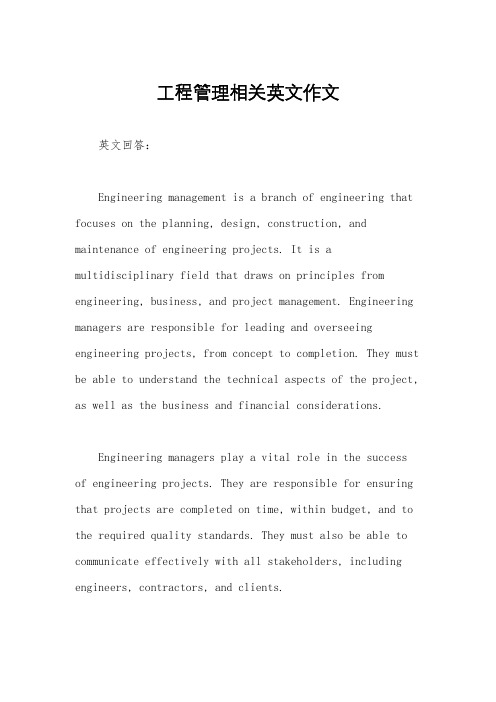
工程管理相关英文作文英文回答:Engineering management is a branch of engineering that focuses on the planning, design, construction, and maintenance of engineering projects. It is a multidisciplinary field that draws on principles from engineering, business, and project management. Engineering managers are responsible for leading and overseeing engineering projects, from concept to completion. They must be able to understand the technical aspects of the project, as well as the business and financial considerations.Engineering managers play a vital role in the success of engineering projects. They are responsible for ensuring that projects are completed on time, within budget, and to the required quality standards. They must also be able to communicate effectively with all stakeholders, including engineers, contractors, and clients.There are a number of different skills and qualifications that are required for success in engineering management. These include:A strong understanding of engineering principles。
工程项目管理论文英文
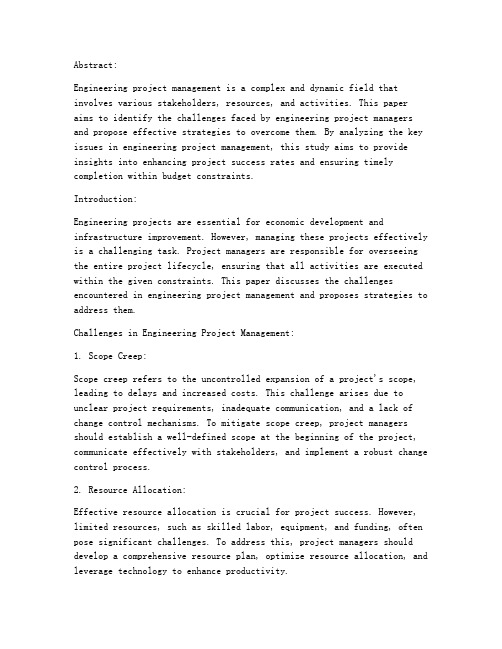
Abstract:Engineering project management is a complex and dynamic field that involves various stakeholders, resources, and activities. This paper aims to identify the challenges faced by engineering project managers and propose effective strategies to overcome them. By analyzing the key issues in engineering project management, this study aims to provide insights into enhancing project success rates and ensuring timely completion within budget constraints.Introduction:Engineering projects are essential for economic development and infrastructure improvement. However, managing these projects effectively is a challenging task. Project managers are responsible for overseeing the entire project lifecycle, ensuring that all activities are executed within the given constraints. This paper discusses the challenges encountered in engineering project management and proposes strategies to address them.Challenges in Engineering Project Management:1. Scope Creep:Scope creep refers to the uncontrolled expansion of a project's scope, leading to delays and increased costs. This challenge arises due to unclear project requirements, inadequate communication, and a lack of change control mechanisms. To mitigate scope creep, project managers should establish a well-defined scope at the beginning of the project, communicate effectively with stakeholders, and implement a robust change control process.2. Resource Allocation:Effective resource allocation is crucial for project success. However, limited resources, such as skilled labor, equipment, and funding, often pose significant challenges. To address this, project managers should develop a comprehensive resource plan, optimize resource allocation, and leverage technology to enhance productivity.3. Time Management:Meeting project deadlines is critical for client satisfaction andproject success. However, time management challenges, such as delays in material deliveries, unexpected issues, and poor coordination, candisrupt the project schedule. To tackle this, project managers should develop a realistic project schedule, establish clear timelines, and monitor progress regularly to identify and address any deviations promptly.4. Communication:Effective communication is essential for successful project management. However, communication barriers, such as language differences, cultural misunderstandings, and conflicting interests, can hinder project progress. To overcome this challenge, project managers should establish open communication channels, foster a collaborative environment, and use appropriate communication tools to facilitate effective information exchange.Strategies to Overcome Challenges:1. Proactive Stakeholder Management:Identify and engage with all stakeholders early in the project lifecycle. Understand their expectations, concerns, and interests, and communicate effectively to ensure their involvement and support throughout the project.2. Robust Project Planning:Develop a comprehensive project plan that includes detailed scope, schedule, budget, and risk management strategies. Regularly review and update the plan to adapt to any changes or unforeseen events.3. Agile Project Management:Implement agile methodologies to enhance flexibility and adaptability. Break the project into smaller, manageable increments, and iterate on deliverables based on feedback and changing requirements.4. Effective Risk Management:Identify, analyze, and prioritize potential risks. Develop risk mitigation strategies and contingency plans to minimize their impact on the project's success.Conclusion:Engineering project management is a complex and challenging field. By identifying the key challenges and implementing effective strategies, project managers can enhance project success rates and ensure timely completion within budget constraints. Continuous improvement, effective communication, and proactive stakeholder management are crucial for overcoming these challenges and achieving project objectives.。
工程项目管理论文双语
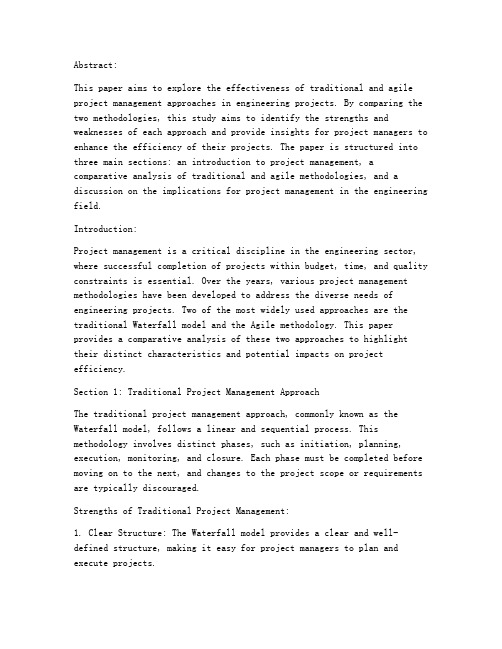
Abstract:This paper aims to explore the effectiveness of traditional and agile project management approaches in engineering projects. By comparing the two methodologies, this study aims to identify the strengths and weaknesses of each approach and provide insights for project managers to enhance the efficiency of their projects. The paper is structured into three main sections: an introduction to project management, a comparative analysis of traditional and agile methodologies, and a discussion on the implications for project management in the engineering field.Introduction:Project management is a critical discipline in the engineering sector, where successful completion of projects within budget, time, and quality constraints is essential. Over the years, various project management methodologies have been developed to address the diverse needs of engineering projects. Two of the most widely used approaches are the traditional Waterfall model and the Agile methodology. This paper provides a comparative analysis of these two approaches to highlight their distinct characteristics and potential impacts on project efficiency.Section 1: Traditional Project Management ApproachThe traditional project management approach, commonly known as the Waterfall model, follows a linear and sequential process. This methodology involves distinct phases, such as initiation, planning, execution, monitoring, and closure. Each phase must be completed before moving on to the next, and changes to the project scope or requirements are typically discouraged.Strengths of Traditional Project Management:1. Clear Structure: The Waterfall model provides a clear and well-defined structure, making it easy for project managers to plan and execute projects.2. Documentation: The emphasis on documentation ensures that all project requirements, plans, and decisions are well-documented and easily accessible.3. Risk Management: The linear nature of the Waterfall model allows for effective risk management by identifying and addressing potential risks at each phase of the project.Weaknesses of Traditional Project Management:1. Rigidity: The Waterfall model is rigid and does not accommodate changes in project requirements or scope.2. Longer Delivery Time: The sequential nature of the Waterfall model often leads to longer delivery times, as each phase must be completed before moving on to the next.3. Less Flexibility: The Waterfall model is less flexible in adapting to changes in project requirements, which can lead to project delays and increased costs.Section 2: Agile Project Management ApproachAgile project management is an iterative and incremental approach that focuses on flexibility, adaptability, and collaboration. This methodology involves breaking the project into smaller, manageable pieces, which are developed and delivered in short cycles known as sprints.Strengths of Agile Project Management:1. Flexibility: Agile allows for changes in project requirements and scope throughout the project lifecycle, making it easier to adapt to evolving needs.2. Early Delivery: The iterative nature of Agile allows for the early delivery of working software, enabling stakeholders to provide feedback and make necessary adjustments.3. Improved Collaboration: Agile emphasizes collaboration among team members, stakeholders, and customers, fostering a more transparent and efficient project environment.Weaknesses of Agile Project Management:1. Complexity: The Agile methodology can be complex to implement and manage, requiring a high level of discipline and commitment from all project participants.2. Documentation: Agile places less emphasis on documentation comparedto the Waterfall model, which can make it challenging to track project progress and changes.3. Scope Creep: The flexibility of Agile can sometimes lead to scope creep, where additional features and requirements are continuously added to the project, leading to delays and increased costs.Section 3: Comparative Analysis and Implications for Engineering Project ManagementComparing the traditional Waterfall model and the Agile methodology, it becomes evident that both approaches have their strengths and weaknesses. The choice of methodology depends on the specific needs and requirements of the engineering project.For projects with well-defined requirements and a fixed scope, the traditional Waterfall model may be more suitable. However, for projects with evolving requirements and a need for flexibility, Agile is often a better choice.The implications of these methodologies for engineering project management are significant. Project managers must understand thedistinct characteristics of each approach and be able to select the most appropriate methodology for their projects. This requires a thorough analysis of project requirements, stakeholder expectations, and the project environment.Conclusion:In conclusion, this paper has provided a comparative analysis of traditional and agile project management approaches in the engineering sector. By understanding the strengths and weaknesses of each approach, project managers can make informed decisions to enhance the efficiencyof their projects. The choice of methodology depends on the specific needs of the project, and a well-informed project manager caneffectively leverage the advantages of both approaches to achieve successful project outcomes.中文摘要:本文旨在探讨传统和敏捷项目管理方法在工程项目中的有效性。
- 1、下载文档前请自行甄别文档内容的完整性,平台不提供额外的编辑、内容补充、找答案等附加服务。
- 2、"仅部分预览"的文档,不可在线预览部分如存在完整性等问题,可反馈申请退款(可完整预览的文档不适用该条件!)。
- 3、如文档侵犯您的权益,请联系客服反馈,我们会尽快为您处理(人工客服工作时间:9:00-18:30)。
